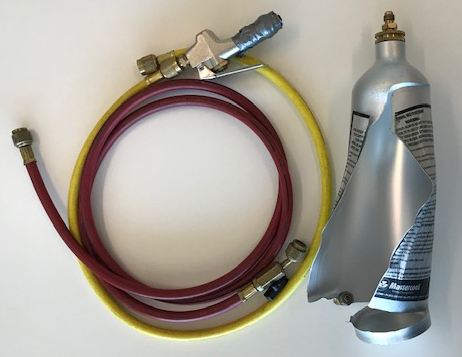Dangers of using pressurised canisters
The purpose of this Safety Alert is to highlight the risk of serious injury when using pressurised flushing canisters to clean out air conditioning systems.
Background
An NT refrigeration mechanic was injured when a flushing canister he was using to clean an air conditioning system over pressurised and ruptured.
The flushing canister contained a cleaning solution used to flush out and clean the pipes of air conditioning units. The flushing canister, which had a safe operating pressure of 1034 kpa was connected to a nitrogen cylinder via a pressure regulator. The storage capacity of the cylinder was 16,000 kpa of pressurised gas.
The flushing canister ruptured when the worker released the hand held flow control.

Possible contributing factors
- Failure to provide safe systems of work (set up and operating procedures) to the worker.
- The flushing canister was imported and the manufacturer’s safe operating instruction was limited in scope.
- The worker released the hand held flow control before turning off the nitrogen cylinder valve.
- The flow pressure from the cylinder’s regulator may not have been set correctly. This allowed a rapid build-up of pressure in the canister causing it to rupture.
Action required
- Consider other options to clean the internal pipes that avoid using high pressure gas (eliminate the risk).
- If pressurised gas flushing system is used, all components of the pressure equipment should be thoroughly inspected for wear or damage before connection and use.
- The flushing canisters should be fitted with an engineered pressure relief device.
- Before the flushing canister is connected, the flow pressure from the regulator must be set according to the flushing canisters manufacturer’s instructions so that the delivery pressure cannot exceed the safe working pressures of the components it supplies.
- If a pressurised flushing system is to be used ensure that before releasing the hand held control valve, the operator first isolates the supply of gas at the cylinder valve and wait for the regulator gauge to drop and indicate “0” pressure. The hand control can then be released.
Further information
For further information, please refer to the following:
Safety Alerts
- Flushing canister bursts (QLD Mine Safety and Health)
Code of Practice
Disclaimer
This Safety Alert contains safety information following inquires made by NT WorkSafe about an incident or unsafe practice. The information contained in this Alert does not necessarily include the outcome of NT WorkSafe’s action with respect to an incident. NT WorkSafe does not warrant the information in this Alert is complete or up-to-date and does not accept any liability for the information in this report or as to its use.